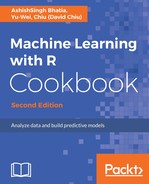Book Description
Explore over 110 recipes to analyze data and build predictive models with simple and easy-to-use R code
About This Book
- Apply R to simplify predictive modeling with short and simple code
- Use machine learning to solve problems ranging from small to big data
- Build a training and testing dataset, applying different classification methods.
Who This Book Is For
This book is for data science professionals, data analysts, or people who have used R for data analysis and machine learning who now wish to become the go-to person for machine learning with R. Those who wish to improve the efficiency of their machine learning models and need to work with different kinds of data set will find this book very insightful.
What You Will Learn
- Create and inspect transaction datasets and perform association analysis with the Apriori algorithm
- Visualize patterns and associations using a range of graphs and find frequent item-sets using the Eclat algorithm
- Compare differences between each regression method to discover how they solve problems
- Detect and impute missing values in air quality data
- Predict possible churn users with the classification approach
- Plot the autocorrelation function with time series analysis
- Use the Cox proportional hazards model for survival analysis
- Implement the clustering method to segment customer data
- Compress images with the dimension reduction method
- Incorporate R and Hadoop to solve machine learning problems on big data
In Detail
Big data has become a popular buzzword across many industries. An increasing number of people have been exposed to the term and are looking at how to leverage big data in their own businesses, to improve sales and profitability. However, collecting, aggregating, and visualizing data is just one part of the equation. Being able to extract useful information from data is another task, and a much more challenging one. Machine Learning with R Cookbook, Second Edition uses a practical approach to teach you how to perform machine learning with R. Each chapter is divided into several simple recipes. Through the step-by-step instructions provided in each recipe, you will be able to construct a predictive model by using a variety of machine learning packages. In this book, you will first learn to set up the R environment and use simple R commands to explore data. The next topic covers how to perform statistical analysis with machine learning analysis and assess created models, covered in detail later on in the book. You'll also learn how to integrate R and Hadoop to create a big data analysis platform. The detailed illustrations provide all the information required to start applying machine learning to individual projects. With Machine Learning with R Cookbook, machine learning has never been easier.
Style and approach
This is an easy-to-follow guide packed with hands-on examples of machine learning tasks. Each topic includes step-by-step instructions on tackling difficulties faced when applying R to machine learning.
